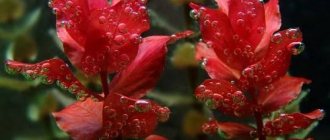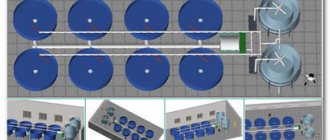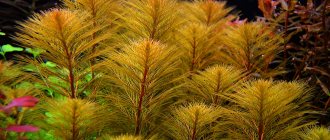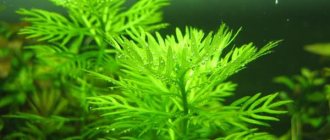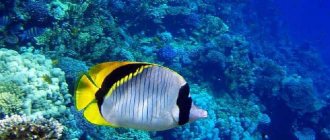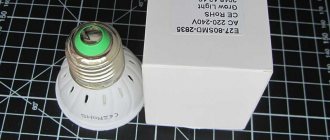- Other names: Didiplis diandra, Peplis diandra (obsolete), Peplis (obsolete), Butterlak two-stamen, Didiplis Diandra.
- Origin: North America.
- Size: 30-60 cm.
- Temperature: 22-28 °C.
- Water parameters: pH 6-8, dKH 2-10 °.
- Lighting: 0.75 W/l.
- Growth rate: average.
- Additional information: requires CO2, best placed in the foreground and center.
- Content difficulty: difficult.
Didiplis cannot be called an unpretentious plant, but it definitely deserves attention. This small, delicate plant can become a spectacular focal point in the foreground of an aquarium. Its color can vary from rich to light shades of green, and the tips of the leaves take on a reddish tint in good light.
The interlacing of pointed leaves of Buterlak looks especially good against the background of round-leaved aquarium plants, grass or stones. With good care, pinkish flowers appear in the axils of its leaves, but they are so small that at first glance it may seem to you that the plant is sick.
In general, this is a delicate, sensitive and light-loving aquarium plant. If the lighting intensity in the aquarium is high enough, the leaves at the tips of the shoots turn red and begin to form discreet flowers.
Conditions of detention
For healthy growth, a supply of carbon dioxide and soft to medium hard water is recommended. The optimal temperature regime is 22-26°C, but for a short time it can be higher.
For plant growth, clean water in the aquarium is necessary, which means frequent water filtration and regular water changes cannot be avoided. It is also worth ensuring that foreign chemicals and algae are removed from the aquarium. They negatively affect the condition of didiplys.
The color of the leaves of this plant depends on the intensity of light. In low light, it stretches out and the leaves turn pale green. In bright light, the whorls of leaves thicken and acquire a brown tint.
It is not recommended to plant the plant in a new aquarium. Only in a prepared aquarium will it ideally occupy the foreground or middle of the aquarium.
Didiplis has a seasonal growth pattern with a dormant period in winter.
Content
Didiplis diandra needs good lighting, 0.6 - 1 watt per liter of water, a predominance of red light is recommended. With less light, the plant at the bottom tends to die and rot. But it should be borne in mind that with more intense lighting, didiplis diandra will need more iron and trace elements. If the plant looks wilted and pale, then this is a sure sign that the aquarium has an iron deficiency.
Additional supply of CO2 to the aquarium is not at all necessary, but with it the plants will be healthier and grow much faster. Fertilizers with macronutrients (nitrogen, phosphate and potassium) should be applied regularly at regular intervals, as well as iron and micronutrients. If you keep Didiplis diandra under optimal conditions, its leaves show colors ranging from orange to red. If the light is less than needed, the plant will remain green. Nutrient soil is not necessary for this plant, but nutrients in it, especially those containing iron, will further stimulate the plant's growth.
The stem can grow to the surface of the water, can produce many side shoots and grows in a very dense "bush". To encourage side shoots to appear, simply cut off the top of the stem.
| Lighting | °C | Total hardness (°dGH) | PH |
| Strong | 22-28 | 4-12 | 6-7,2 |
Care
In terms of content, Didiplis is a complex species. It grows relatively slowly, but beautifully. And to properly care for it, it is very important to provide the proper conditions.
Let us point out, first of all, that the plant is not able to exist and develop normally in low light conditions. Therefore, daylight for didiplis should be at least 12 hours. Additionally, it is necessary to ensure the availability of high-quality nutrient soil if you intend to successfully grow the plant in question. The best soil option is a mixture of coarse sand and clay. It is very important that the top layer of soil is clean and free of silt.
The water should have a moderate temperature in the range of 22-26 degrees and be soft or medium hard. To simplify maintenance, it is advisable to install an additional supply of carbon dioxide. This, by the way, will somewhat accelerate the growth of the flora representative. In any case, it is important that the carbon dioxide concentration is not too low, otherwise the didiplys will stop its growth. Good filtration is also necessary. Otherwise, dirt will begin to accumulate on the didiplys leaves, which will result in the plant becoming overgrown with algae.
After purchasing a plant, it must be placed in an aquarium. The recommended minimum aquarium volume is 40 liters. It is advisable to plant in the middle zone. True, if the aquarium is large enough, then it is possible to plant didiplys near the front wall. Let us remind you: the plant needs sufficient lighting. Therefore, when placing it in an aquarium, you must make sure that didiplys is not shaded by other taller species.
In general, the didiplys plant is very pretty, and due to its unusual color and shape of the leaves, it stands out from all other aquarium plants. In addition, it is very easy to propagate: you just need to pinch off a side branch and simply plant it near an already formed bush. Therefore, feel free to add it to your collection of underwater flora.
Description
Didiplis diandra is a fairly short plant. Its stems are erect and very branched; they reach a height of about 10-15 cm. If conditions are extremely favorable, then it is possible to grow a 35-centimeter miracle.
Two-stamen butterflower is characterized by the presence of very small flowers with quadrangular sepals. It also has fairly thick, needle-shaped leaves without a petiole.
The color of the stem is red; there are very abundant green-yellow leaves on it. However, if two-stamen Buterlac is kept in conditions of high light intensity, then its tops will also acquire a reddish tint, as a result of which Didiplis becomes even more attractive. If the lighting remains moderate (approximately 0.5 watt/l), then there is a chance to become the owner of a lush, richly green plant.
Prevalence in nature
Diandra loves warmth and a lot of light. This delicate plant naturally grows in clean reservoirs of shallow depth and with a slow current. These can be shallow rivers, small lakes and ponds. Buterlak grows mainly in shallow water or along the coast. It likes swampy soil - one with a lot of clay, and water - soft and clean. Didiplis is distributed mainly in the eastern part of North America, where there is a lot of sun and suitable bodies of water.
Where does didiplis grow in the wild?
Didiplis can be found in Central and South America. Prefers shallow areas of rivers where the current is very slow, as well as the banks of lakes and small ponds. But the plant is most comfortable in swamps where the soil is clayey. Didiplis can grow both in water and above it.
Didiplis has been known since 1828, when botanists first described this species and selected a classification for it. The plant belongs to the Derbennikov or Crassula family, the species is called Peplis diandra, another name, used no less often, is Didiplis diandra.
Didiplis has several other names - two-stamen buretlak, two-stamen butyrlak. All these are different names for the same grass from South American rivers and lakes, which is loved by many aquarists.
Properties and Features
Didiplis is perfect for creating aquarium compositions. It is typically used to add perspective to a design. And the reddish and small leaves contrast beautifully with the large-leaved green algae. Buterlak is often considered as an analogue of a common aquarium plant - Indian rotala, which is not so demanding of environmental conditions, but grows too quickly, which is not entirely appropriate for aquascaping.
But the double-stamened Buterlak grows much more slowly, which makes it more suitable for creating an aquarium design. Typically, didiplis diandra is placed in the depths of the aquarium tank in its central part - it is with this arrangement that the small leaves and their reddish color create the impression of depth in the composition.
Important! Didiplis diandra is a medium-difficulty aquarium plant that requires constant and regular care, as well as maintaining a constant habitat.
Appearance
The plant has a long and powerful stem (in nature it grows up to 60 cm) from which many small leaves grow. The width of one leaf is no more than 3 mm, and the length is up to 3 cm. In nature, didlis is capable of blooming with small greenish flowers, but in aquarium conditions this is very difficult to achieve.
The roots are poorly developed, but new nodules appear from them, from which shoots are obtained. In appearance, didlis resembles a beautiful green bush. The plant has an unusual property: with a good level of light, the color of the leaves changes from green to pale red.
Breeding didiplys
One of the conditions for planting peplis is long-term stable operation of the aquarium.
This means that the plant will not take root in a new, newly launched aquarium. The reason is clear: the instability of the chemical composition of the water in the new aquatic system. There are 2 methods of propagation: cuttings and shoots.
- In the first case, a shoot with roots is separated from the main bush and planted in the ground. You can even plant only the root, without the stem. The main thing is not to break it.
- The second option is somewhat simpler: the top of the main stem, about 10 cm long, is cut off and planted in the ground.
According to some sources, not every such “seedling” takes root; the success rate of such propagation is about 70%.
However, many experts refute this statement, arguing that planting the top of the stem is a common method of propagation.
Well, there is a reason to test both methods in practice yourself.
The growth rate of the new didiplys is quite high: in the summer, under optimal conditions, a new bush can grow by 10 cm in a month. It is possible to regulate the growth rate by changing the light level, as well as changing the concentration of CO2 supplied to the aquarium.
External characteristics
Didiplis is similar to Indian rotala in that it has the same long stem. Its height in its natural growing environment reaches 60 cm. The stem contains numerous leaves of a narrow, oblong shape.
The stem of the plant is highly durable and has an oval cross-section. If you look briefly at the leaf blades, they resemble fir. From one whorled node emerges up to 4 narrow leaves, devoid of petioles. The length of each reaches 2.5 cm, width - up to 3 mm, no more.
In its natural habitat, Didiplis reproduces vegetatively. During this period, small green flowers , small and completely inconspicuous in appearance, the diameter of each does not exceed 2 mm. The flowering process occurs in the leaf axils. The likelihood that didiplys will bloom in an aquarium is practically non-existent, but sometimes it does happen.
Didiplis has a very weak, delicate root system . From 1 root node 2 or more stems can grow simultaneously. The stems also have shoots. In appearance, didiplis looks like a spreading, well-grown green bush.
Name variations
Didiplis Diandra has a number of alternative names:
- Peplis diandra;
- Peplis Diandra;
- Butterlak Two-stamen;
- Plus sign plant;
- Didiplis diandra (De Candolle);
- Water hedge, Synonyms.
The full botanical name is Didiplis diándra (Nutt. ex DC.).

